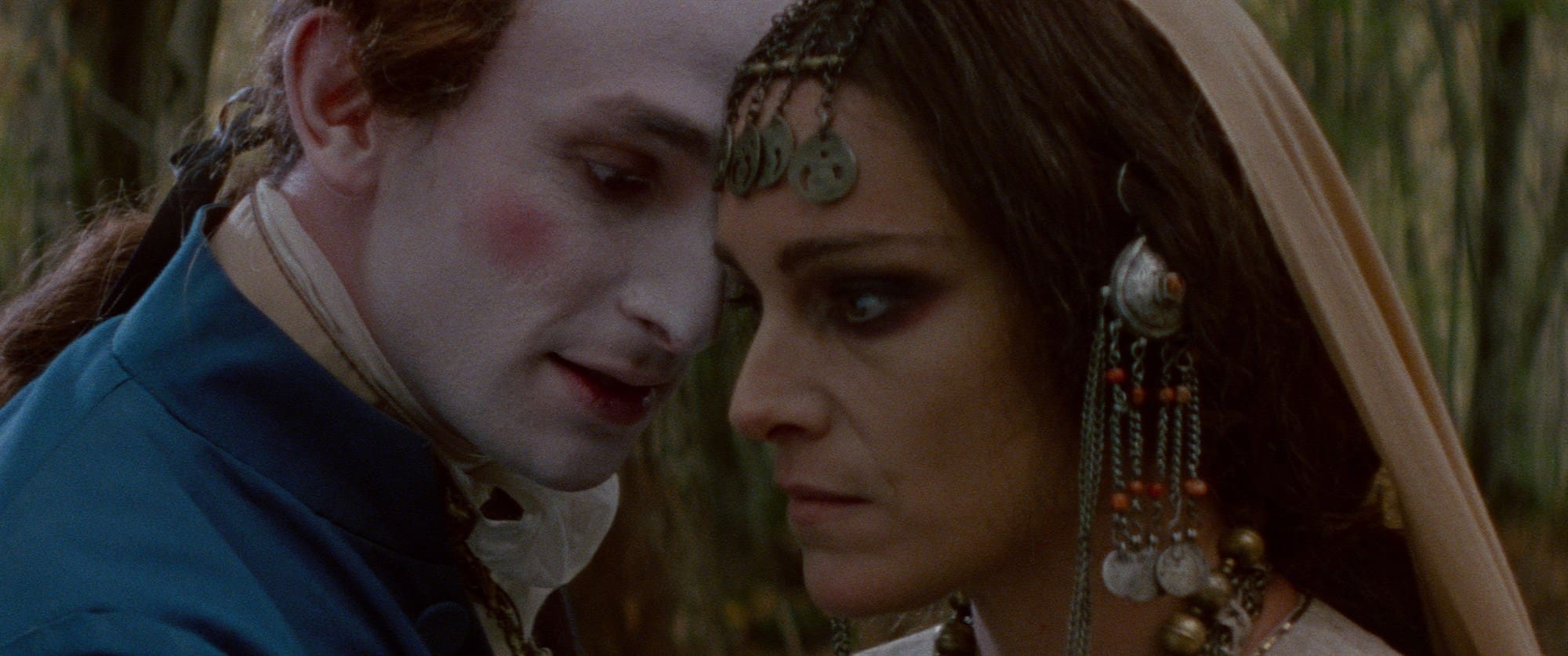
Adapted by co-writer Hadrien Bouvier and director Adrien Beau (who also performs as the Vourdalak) from Aleksei Tolstoy’s story, The Vourdalak follows an obnoxious French nobleman (Kacey Mottet Klein). Lost in the woods, the nobleman is taken to a castle, belonging to his savior’s family. At this castle awaits a sister (Ariane Labed), elder brother, (Gregoire Colin), sister-in-law (Claire Duburcq), and nephew (Erwan Ribard). Here, they wait for the patriarch of the family to return. Having gone off to fight the Turks, the elder brother fears for his elderly father’s life. Aware of the danger, the patriarch left a note for his family, telling them that if he does not return by the 6th day at 6pm, he is surely dead, and if he does return after this time, he will not be the father they knew, but a Vourdalak. If this happens, they’re instructed to turn him away no matter what he says. So, of course the patriarch returns at 6:01.
The most immediately striking element of The Vourdalak is the title character’s design. The way the build-up to the creature’s revelation almost has the same feeling as your eyes adjusting to darkness. You’ll look closely, inquisitive but uncertain, until your eyes adjust and you realize what you really knew all along: the Vourdalak is a puppet. The design and movement would fit just fine in an episode of Sesame Street, but this aesthetic does not contradict the film’s gothic tone. It complements it. The way the Vourdalak’s shadows move against a wall, how his body crawls along a ceiling, are the embodiment of a thing that goes bump in the night. The sound it creates is similarly unnerving. What sounds like boots walking in mud turns out to be a grotesque chewing of rags. This purpose, it seems, is not dissimilar to that of a child using a pacifier: it’s something to keep its mouth busy.
Beyond the design of the Vourdalak, the film aesthetically fires on all cylinders. In this digital age, film is rarely used properly, and sometimes it’s not even used to replicate that “film look.” It’s often too expensive for independent filmmakers. Blockbusters like Jurassic World: Dominion pride themselves for shooting on 65mm when the digital intermediate all but makes it look like a sitcom, and filmmakers like David Fincher can effectively recreate classic aesthetics on 8k resolution digital cameras. That said, that the low budget Vourdalak was not only shot on 16mm film, but actually embraces the format, is a welcome miracle. David Chizallet’s cinematography gives a foggy haze to each image, sometimes inspiring a relaxing comfort, at others, the uncertain fear inspired by the patriarch. Its interiors, particularly the dining hall, light its characters with a warmth from a fire, making you comfortable from the source while still uncertain of what could be in the shadows, and the impact it has on its exteriors inspire you to wonder just how far the Vouralak’s grasp on the world can go.
Whatever grasp on the world the Vourdalak may have, his grasp on the characters within the film varies. Some naively trust him, others don’t, but those that don’t trust him are fighting an uphill battle. That the film allegorizes the parasitic nature of patriarchy is not subtle, but it is earnest, and it resonates. The Vourdalak prays on the insecurities of each member of his family: mocking the non-conforming dress of his youngest child, promising power to his eldest, and telling his daughter-in-law that he can alleviate his grandson/her son’s sickness (when he’s the one causing the sickness.)
This makes the French nobleman an interesting and distrustful avatar for the audience. He comes to the castle for survival, but stays to get with the daughter. He woos her with traditional, polite courtship methods, only to grab her by the arm when she rebukes his advances. Following this physical force, she tricks him into walking off the edge of a cliff (he grabs the cliffside just in time), establishing her understanding of this new world he inhabits. After establishing this dominance, however, he understands his place in this world rather quickly, and mere minutes after threat of death, they walk pleasantly alongside each other, learning more about one another.
Following an earnest threat of death with pleasant conversation captures the essence of The Vourdalak very nicely. The juxtaposition is not humorous, but earnest, in a way that’s in keeping with stories about vampires. They lure you in with the pleasantries, and the attractiveness of these pleasantries is not denied, but the danger they conceal shouldn’t be, and won’t be, too far from sight.


Comments are closed.